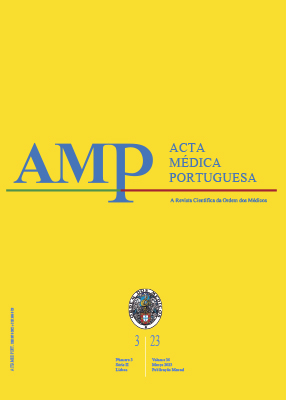Addictive Potential of Social Media: A Cross Sectional Study in Portugal
DOI:
https://doi.org/10.20344/amp.18470Keywords:
Behavior, Addictive, Internet, Internet Addiction Disorder, Psychiatric Status Rating Scales, Social MediaAbstract
Introduction: The use of social media is an extremely popular activity, with an average time spent of two and a half hours daily. The number of users continues to rise, with 4.65 billion around the world in 2022, approximately 58.7% of the world population. A rising number of studies show that a minority of these persons will develop a behavioral addiction on social media. The aim of this study was to understand if the use of a specific social media platform predicts increased addictive potential.
Material and Methods: A cross-sectional sample of 300 persons (aged 18 years-old or older, 60.33% female), completed an online survey including sociodemographic questions, data regarding the use of social media and the Bergen Social Media Addiction Scale (BSMAS). Linear and logistic regression models were performed to determine the risk for each media platform.
Results: Instagram® use was a significant predictor of higher scores on the BSMAS (B 2.51; p < 0.0001; CI 1.33 - 3.69). The use of other platforms including Facebook® (B -0.31), Twitter® (B 1.38) and Pinterest® (B -0.15) was not found to predict a higher risk of social media addiction.
Conclusion: Instagram® scored a higher grade in BSMAS scale, with statistical significance, which could suggest a higher addictive potential. More research is needed to establish the direction of this relationship, since the cross-sectional study design does not allow inferences about directionality.
Downloads
References
Boyd Danah M, Ellison NB. Social network sites: definition, history, and scholarship. J Comput-Mediat Commun. 2007;13:210-30.
Kuss DJ, Griffiths MD. Online social networking and addiction – a review of the psychological literature. Int J Environ Res Public Health. 2011;8:3528-52.
DataReportal – Global Digital Insights. Global social media statistics. [cited 2022 Apr 22]. Available from: https://datareportal.com/social-media-users.
Modica CA. The associations between Instagram use, selfie activities, appearance comparison, and body dissatisfaction in adult men. Cyberpsychology Behav Soc Netw. 2020;23:90-9.
Brown Z, Tiggemann M. Attractive celebrity and peer images on Instagram: effect on women’s mood and body image. Body Image. 2016;19:37-43.
Kleemans M, Daalmans S, Carbaat I, Anschütz D. Picture perfect: the direct effect of manipulated Instagram photos on body image in adolescent girls. Media Psychol. 2018;21:93-110.
Tiggemann M, Barbato I. “You look great!”: the effect of viewing appearance-related Instagram comments on women’s body image. Body Image. 2018;27:61-6.
Holland G, Tiggemann M. A systematic review of the impact of the use of social networking sites on body image and disordered eating outcomes. Body Image. 2016;17:100-10.
Vernon L, Barber BL, Modecki KL. Adolescent problematic social networking and school experiences: the mediating effects of sleep disruptions and sleep quality. Cyberpsychology Behav Soc Netw. 2015;18:386-92.
De Cock R, Vangeel J, Klein A, Minotte P, Rosas O, Meerkerk GJ. Compulsive use of social networking sites in Belgium: prevalence, profile, and the role of attitude toward work and school. Cyberpsychology Behav Soc Netw. 2014;17:166-71.
Kircaburun K. Self-esteem, daily internet use and social media addiction as predictors of depression among Turkish adolescents. J Educ Pract. 2016;9:64-72.
Andreassen CS, Torsheim T, Pallesen S. Use of online social network sites for personal purposes at work: does it impair self-reported performance? Compr Psychol. 2014;3:Article 18.
Andreassen CS. Online social network site addiction: a comprehensive review. Curr Addict Rep. 2015;2:175-84.
Andreassen CS, Pallesen S, Griffiths MD. The relationship between addictive use of social media, narcissism, and self-esteem: findings from a large national survey. Addict Behav. 2017;64:287-93.
Griffiths MD, Kuss DJ, Demetrovics Z. Social networking addiction. In: Behavioral addictions. Amsterdam: Elsevier; 2014.p.119-41.
Kircaburun K, Griffiths MD. Instagram addiction and the big five of personality: the mediating role of self-liking. J Behav Addict. 2018;7:158-70.
Kuss DJ, Griffiths M. Social networking sites and addiction: ten lessons learned. Int J Environ Res Public Health. 2017;14:311.
Griffiths M. A ‘components’ model of addiction within a biopsychosocial framework. J Subst Use. 2005;10:191-7.
Andreassen CS, Billieux J, Griffiths MD, Kuss D, Demetrovics Z, Mazzoni E, et al. The relationship between addictive use of social media and video games and symptoms of psychiatric disorders: a large-scale cross-sectional study. Psychol Addict Behav. 2016;30:252-62.
Biolcati R, Mancini G, Pupi V, Mugheddu V. Facebook addiction: onset predictors. J Clin Med. 2018;7:118.
Andreassen CS, Torsheim T, Brunborg GS, Pallesen S. Development of a Facebook Addiction Scale. Psychol Rep. 2012;110:501-17.
Statistica. Instagram - Statistics & Facts | Statista. [cited 2022 Apr 11]. Available from: https://www.statista.com/topics/1882/instagram/.
Smith C. Here’s why Instagram’s demographics are so attractive to brands. Business Insider. [cited 2022 Apr 20]. Available from: https://www.businessinsider.com/instagram-demographics-2013-12.
Lyfemarketing. 32 social media marketing statistics you should know this 2019. Digit Mark Blog. [cited 2022 Apr 11]. Available from: https://www.lyfemarketing.com/blog/social-media-marketing-statistics/.
Statistica. Smartphone users worldwide 2020. Statista. [cited 2022 Apr 11]. Available from: https://www.statista.com/statistics/330695/number-ofsmartphone-users-worldwide/.
Pontes HM, Andreassen CS, Griffiths MD. Portuguese validation of the Bergen Facebook Addiction Scale: an empirical study. Int J Ment Health Addict.2016;14:1062–73.
Downloads
Published
How to Cite
Issue
Section
License
Copyright (c) 2023 Acta Médica Portuguesa

This work is licensed under a Creative Commons Attribution-NonCommercial 4.0 International License.
All the articles published in the AMP are open access and comply with the requirements of funding agencies or academic institutions. The AMP is governed by the terms of the Creative Commons ‘Attribution – Non-Commercial Use - (CC-BY-NC)’ license, regarding the use by third parties.
It is the author’s responsibility to obtain approval for the reproduction of figures, tables, etc. from other publications.
Upon acceptance of an article for publication, the authors will be asked to complete the ICMJE “Copyright Liability and Copyright Sharing Statement “(http://www.actamedicaportuguesa.com/info/AMP-NormasPublicacao.pdf) and the “Declaration of Potential Conflicts of Interest” (http:// www.icmje.org/conflicts-of-interest). An e-mail will be sent to the corresponding author to acknowledge receipt of the manuscript.
After publication, the authors are authorised to make their articles available in repositories of their institutions of origin, as long as they always mention where they were published and according to the Creative Commons license.









